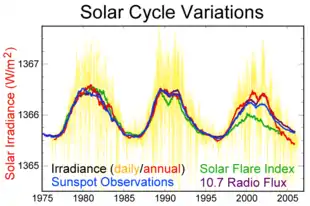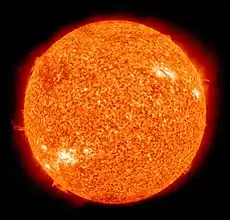List of solar cycles
The following is a list of solar cycles (sometimes called sunspot cycles), tracked since 1755 following the original numbering proposed by Rudolf Wolf in the mid-19th century. The source data are the revised International Sunspot Numbers (ISN v2.0), as available at SILSO.[1] Sunspot counts exist since 1610[2] but the cycle numbering is not well defined during the Maunder minimum.[3] It was proposed that one cycle might have been lost in the late 18th century,[4] but this still remains not fully confirmed.
The smoothing is done using the traditional SIDC smoothing algorithm.[5] Using this algorithm, if the month in question is notated month 0, a weighted average is formed of months -6 to 6, where months -5 to 5 are given weightings of 1, and months -6 and 6 are given weightings of 0.5. Other smoothing formulas exist, and they usually give slightly different values for the amplitude and timings of the solar cycles. An example is the Meeus smoothing formula,[6] with related solar cycles characteristics available in this STCE news item.[7]
The start of solar cycle 25 was declared by SIDC on September 15 2020 as being in December 2019.[8] This makes cycle 24 the only "11-year solar cycle" to have lasted precisely 11 years.
| Solar Cycle | Start (Minimum) | Smoothed minimum ISN (start of cycle) | Maximum | Smoothed maximum ISN | Average spots per day | Time of Rise (years) | Duration (years) | Spotless days[9][10] |
|---|---|---|---|---|---|---|---|---|
| Solar cycle 1 | 1755-02 | 14.0 | 1761-06 | 144 | 6.3 | 11.3 | ||
| Solar cycle 2 | 1766-06 | 18.6 | 1769-09 | 193 | 3.3 | 9.0 | ||
| Solar cycle 3 | 1775-06 | 12.0 | 1778-05 | 264 | 2.9 | 9.3 | ||
| Solar cycle 4 | 1784-09 | 15.9 | 1788-02 | 235 | 3.4 | 13.6 | ||
| Solar cycle 5 | 1798-04 | 5.3 | 1805-02 | 82 | 6.8 | 12.3 | ||
| Solar cycle 6 | 1810-08 | 0.0 | 1816-05 | 81 | 5.8 | 12.8 | ||
| Solar cycle 7 | 1823-05 | 0.2 | 1829-11 | 119 | 6.5 | 10.5 | ||
| Solar cycle 8 | 1833-11 | 12.2 | 1837-03 | 245 | 3.3 | 9.7 | ||
| Solar cycle 9 | 1843-07 | 17.6 | 1848-02 | 220 | 4.6 | 12.4 | ||
| Solar cycle 10 | 1855-12 | 6.0 | 1860-02 | 186 | 92 | 4.2 | 11.3 | 561 |
| Solar cycle 11 | 1867-03 | 9.9 | 1870-08 | 234 | 89 | 3.4 | 11.8 | 942 |
| Solar cycle 12 | 1878-12 | 3.7 | 1883-12 | 124 | 57 | 5.0 | 11.3 | 872 |
| Solar cycle 13 | 1890-03 | 8.3 | 1894-01 | 147 | 65 | 3.8 | 11.8 | 782 |
| Solar cycle 14 | 1902-01 | 4.5 | 1906-02 | 107 | 54 | 4.1 | 11.5 | 1007 |
| Solar cycle 15 | 1913-07 | 2.5 | 1917-08 | 176 | 73 | 4.1 | 10.1 | 640 |
| Solar cycle 16 | 1923-08 | 9.4 | 1928-04 | 130 | 68 | 4.7 | 10.1 | 514 |
| Solar cycle 17 | 1933-09 | 5.8 | 1937-04 | 199 | 96 | 3.6 | 10.4 | 384 |
| Solar cycle 18 | 1944-02 | 12.9 | 1947-05 | 219 | 109 | 3.3 | 10.2 | 382 |
| Solar cycle 19 | 1954-04 | 5.1 | 1958-03 | 285 | 129 | 3.9 | 10.5 | 337 |
| Solar cycle 20 | 1964-10 | 14.3 | 1968-11 | 157 | 86 | 4.1 | 11.4 | 285 |
| Solar cycle 21 | 1976-03 | 17.8 | 1979-12 | 233 | 111 | 3.8 | 10.5 | 283 |
| Solar cycle 22 | 1986-09 | 13.5 | 1989-11 | 214 | 106 | 3.2 | 9.9 | 257 |
| Solar cycle 23 | 1996-08 | 11.2 | 2001-11 | 180 | 82 | 5.3 | 12.3 | 619 |
| Solar cycle 24 | 2008-12 | 2.2 | 2014-04 | 116 | 49 | 5.3 | 11.0 | 914 |
| Solar cycle 25 | 2019-12 | 1.8 | Progressive: 8.8 (Jul 2020) | 235 (Feb 2 2021) | ||||
| Average | 9.0 | 178.7 | 4.4 | 11.04 |
The following table is instead divided into (unofficial) cycles starting and ending with a maximum, to give a better feel for the number of spotless days associated with each minimum:
| Solar Cycles | “Start” (Maximum) | Spotless days |
|---|---|---|
| Solar cycle 10-11 | 1860-02 | 406 |
| Solar cycle 11-12 | 1870-08 | 1028 |
| Solar cycle 12-13 | 1883-12 | 736 |
| Solar cycle 13-14 | 1894-01 | 934 |
| Solar cycle 14-15 | 1906-02 | 1023 |
| Solar cycle 15-16 | 1917-08 | 534 |
| Solar cycle 16-17 | 1928-04 | 568 |
| Solar cycle 17-18 | 1937-04 | 269 |
| Solar cycle 18-19 | 1947-05 | 446 |
| Solar cycle 19-20 | 1958-03 | 227 |
| Solar cycle 20-21 | 1968-11 | 272 |
| Solar cycle 21-22 | 1979-12 | 273 |
| Solar cycle 22-23 | 1989-10 | 309 |
| Solar cycle 23-24 | 2001-11 | 817 |
| Solar cycle 24-25 | 2014-04 | 812 (Feb 2 2021) |
Following is a comparison of the growth of cycle 25 versus cycle 24, using the 13-month sunspot averages, beginning with the months of the respective minimums.
Numbers in brackets for cycle 25 indicate the minimum possible value for that month, assuming there are no more sunspots between now (2 Feb 2021) and six months after the end of the month in question.
| Solar Cycle 24 | Solar Cycle 25 | ||
|---|---|---|---|
| Dec 2008 | 2.2 | Dec 2019 | 1.8 |
| Jan 2009 | 2.5 | Jan 2020 | 2.2 |
| Feb 2009 | 2.7 | Feb 2020 | 2.7 |
| Mar 2009 | 2.9 | Mar 2020 | 3.0 |
| Apr 2009 | 3.3 | Apr 2020 | 3.6 |
| May 2009 | 3.5 | May 2020 | 5.5 |
| Jun 2009 | 4.1 | Jun 2020 | 7.8 |
| Jul 2009 | 5.5 | Jul 2020 | 8.8 |
| Aug 2009 | 7.4 | Aug 2020 | (8.9) |
| Sep 2009 | 9.5 | Sep 2020 | (8.9) |
| Oct 2009 | 11 | Oct 2020 | (8.6) |
| Nov 2009 | 12 | Nov 2020 | (8.4) |
| Dec 2009 | 13 | Dec 2020 | (8.1) |
| Jan 2010 | 14 | Jan 2021 | |
| Feb 2010 | 16 | Feb 2021 | |
| Mar 2010 | 19 | Mar 2021 | |
| Apr 2010 | 21 | Apr 2021 | |
| May 2010 | 23 | May 2021 | |
| Jun 2010 | 25 | Jun 2021 | |
| Jul 2010 | 25 | Jul 2021 | |
| Aug 2010 | 26 | Aug 2021 | |
| Sep 2010 | 29 | Sep 2021 | |
| Oct 2010 | 34 | Oct 2021 | |
| Nov 2010 | 39 | Nov 2021 | |
| Dec 2010 | 42 | Dec 2021 | |
| Jan 2011 | 46 | Jan 2022 | |
| Feb 2011 | 49 | Feb 2022 | |
| Mar 2011 | 54 | Mar 2022 | |
| Apr 2011 | 61 | Apr 2022 | |
| May 2011 | 69 | May 2022 | |
| Jun 2011 | 77 | Jun 2022 | |
| Jul 2011 | 84 | Jul 2022 | |
| Aug 2011 | 86 | Aug 2022 | |
| Sep 2011 | 87 | Sep 2022 | |
| Oct 2011 | 87 | Oct 2022 | |
| Nov 2011 | 89 | Nov 2022 | |
| Dec 2011 | 92 | Dec 2022 | |
| Jan 2012 | 95 | Jan 2023 | |
| Feb 2012 | 98 | Feb 2023 | |
| Mar 2012 | 98 | Mar 2023 | |
| Apr 2012 | 95 | Apr 2023 | |
| May 2012 | 91 | May 2023 | |
| Jun 2012 | 87 | Jun 2023 | |
| Jul 2012 | 84 | Jul 2023 | |
| Aug 2012 | 85 | Aug 2023 | |
| Sep 2012 | 85 | Sep 2023 | |
| Oct 2012 | 86 | Oct 2023 | |
| Nov 2012 | 88 | Nov 2023 | |
| Dec 2012 | 88 | Dec 2023 | |
| Jan 2013 | 87 | Jan 2024 | |
| Feb 2013 | 86 | Feb 2024 | |
| Mar 2013 | 84 | Mar 2024 | |
| Apr 2013 | 84 | Apr 2024 | |
| May 2013 | 87 | May 2024 | |
| Jun 2013 | 91 | Jun 2024 | |
| Jul 2013 | 95 | Jul 2024 | |
| Aug 2013 | 99 | Aug 2024 | |
| Sep 2013 | 105 | Sep 2024 | |
| Oct 2013 | 107 | Oct 2024 | |
| Nov 2013 | 107 | Nov 2024 | |
| Dec 2013 | 108 | Dec 2024 | |
| Jan 2014 | 109 | Jan 2025 | |
| Feb 2014 | 111 | Feb 2025 | |
| Mar 2014 | 114 | Mar 2025 | |
| Apr 2014 | 116 | Apr 2025 |
The final 3 months of 2020 averaged 22.8 spots per day, with 11 spotless days. This compares with 10.3 spots per day and 46 spotless days for the same period in SC24.
2020 had 80% more spots than for the same period of SC24.
These figures are in early agreement with a new paper (October 2020) by McIntosh et. al.[11] which projects that solar cycle 25 will almost certainly be stronger than SC24 (ISN max 116), and most likely stronger than SC23 (ISN max 180).
References
- "Sunspot numbers". WDC-SILSO. Royal Observatory of Belgium. Retrieved 19 May 2017.
- Hathaway, D. (2015). "The solar cycle". Living Reviews in Solar Physics. 12 (1): 4. arXiv:1502.07020. Bibcode:2015LRSP...12....4H. doi:10.1007/lrsp-2015-4. PMC 4841188. PMID 27194958.
- Usoskin; Mursula; Kovaltsov (2001). "Heliospheric modulation of cosmic rays and solar activity during the Maunder minimum". J. Geophys. Res. 106(A8) (A8): 16039. Bibcode:2001JGR...10616039U. doi:10.1029/2000JA000105.
- Usoskin; et al. (2009). "A solar cycle lost in 1793-1800: Early sunspot observations resolve the old mystery". Astrophys. J. Lett. 700 (2): L154. arXiv:0907.0063. Bibcode:2009ApJ...700L.154U. doi:10.1088/0004-637X/700/2/L154. S2CID 14882350.
- "SIDC smoothing formula". WDC-SILSO. Royal Observatory of Belgium. Retrieved 19 May 2017.
- Meeus, J. (1958). "Une formule d'adoucissement pour l'activité solaire". Ciel et Terre. 74: 445. Bibcode:1958C&T....74..445M.
- "The solar cycle's new clothes". STCE. Royal Observatory of Belgium. Retrieved 8 July 2015.
- "December 2019 confirmed as starting point of the new solar activity cycle". SIDC.
- "What's Wrong with the Sun?". NASA Science. NASA. Retrieved 29 July 2014.
- "Spotless Days Page". SILSO. Royal Observatory of Belgium. Retrieved 3 April 2017.
- McIntosh, Scott W.; Chapman, Sandra; Leamon, Robert J.; Egeland, Ricky; Watkins, Nicholas W. (2020). "Overlapping Magnetic Activity Cycles and the Sunspot Number: Forecasting Sunspot Cycle 25 Amplitude" (PDF). Solar Physics. 295 (12): 163. arXiv:2006.15263. Bibcode:2020SoPh..295..163M. doi:10.1007/s11207-020-01723-y. S2CID 220250556.
External links
- Solar Influences Data Analysis Center (SIDC)
- Graphics of historic solar cycles at the SIDC page
- Near realtime solar images from SOHO
- SORCE Total Solar Irradiance (TSI) Data

